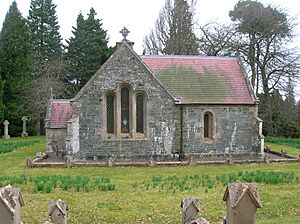Dawyck Chapel facts for kids
Dawyck Chapel, also called Dalwick Church, is a special building found in the Scottish Borders area of Scotland. It's located inside the beautiful Dawyck Botanic Gardens. This garden is like a branch of the famous Royal Botanic Garden Edinburgh. The chapel is about 8 miles (13 km) southwest of Peebles and a similar distance southeast of Biggar.
Contents
History of Dawyck Chapel
Who Owned the Dawyck Estate?
The Dawyck estate has a long history with different families. The Veitch family owned this land for 200 years, from 1491 to 1691.
Then, in 1691, the Naesmyth family took over. A notable owner was Sir James Naesmyth, the 2nd Baronet, who lived from 1704 to 1779. Later, his grandson, Sir John Murray Naesmyth, owned the estate from 1803 to 1876.
In 1897, Mrs. Alexander Balfour bought the estate. Her grandson, Colonel A.N. Balfour, later sold most of the property. However, he generously gave the gardens to the nation in 1978. This means the gardens became a public treasure for everyone to enjoy.
The Chapel's Story
The name 'Dawyck' has been spelled in different ways over time, like 'Dawic' and 'Dauwic' around the year 1200. The name might come from old words meaning "ox" and "camp" or "dwelling."
Before the Reformation in 1598, Dawyck Chapel was part of Stobo Parish. Soon after, it became its own independent parish. However, in 1742, the parish was closed down. Sir James Naesmyth, the 2nd Baronet, made this decision to save money. The money that used to support the Dawyck church was then given to the parishes of Stobo and Drumelzier.
In 1789, Sir James Naesmyth, the 3rd Baronet, bought the old church land, called the 'glebe'. This land was about 4 acres (1.6 hectares) and was located southwest of the church. It also came with rights to let animals graze there, like a horse, two cows, and forty sheep.
In 1837, the old chapel ruins were taken down. Sir John Murray Naesmyth, a lawyer, had them removed to build the chapel we see today. This new chapel also serves as the family's mausoleum, which is a building where family members are buried.
Inside the chapel, you can still find a very old font, which might be from the medieval period. The chapel bell is said to have been made in 1642 and then recast, or melted down and reshaped, in 1791.
Even though it's a private property, Dawyck Chapel is still used for special events like weddings.
Views of the Chapel and Gardens
See also
- List of places in the Scottish Borders
- List of places in East Lothian
- List of places in Edinburgh
- Stobo Kirk






